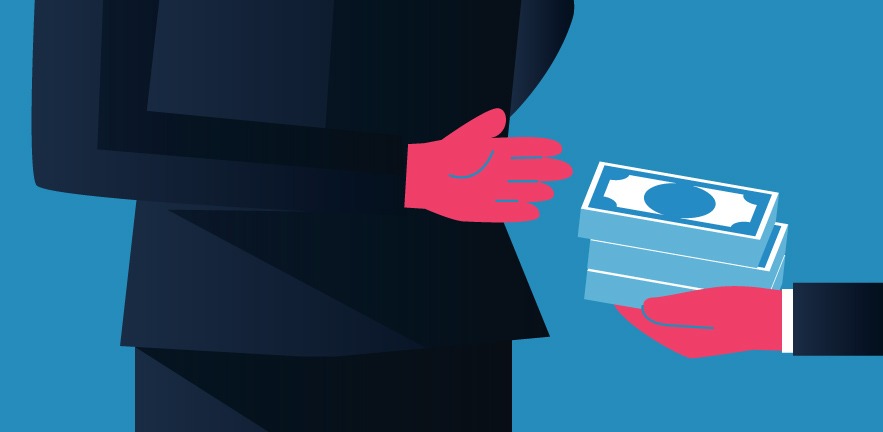New study co-authored by Professor Raghu Rau finds that $1 in bribes is linked to $6 to $9 increases in the value of bribing firms, but the research punctures some common bribery beliefs.


Bribery is a key concern of governments and companies around the world. In recent decades, large multinational firms including Siemens, BAe Systems, Lockheed Martin and Halliburton have been the subject of reports about alleged bribery of government officials. Many such cases have been settled with authorities after firms agreed to pay big fines.
But what determines the benefits that companies receive from bribery?
A new study examines nearly 200 reported cases over four decades to find a link between the size of bribes and benefits – with $1 in bribes translating to $6 to $9 increases in market capitalisation. It also punctures some common beliefs, finding no support for such assumptions that the size of the bribe is linked to the size of the benefit to bribing firms or that explicit anti-bribery enforcement reduces the size of the benefits firms receive.
Given that bribery is illegal and undisclosed, most previous studies have made use of questionnaires and surveys of corruption perceptions at a macro level. However, surveyed companies may not answer questionnaires truthfully, and corruption perceptions may be affected by media coverage.
The new study co-authored by Professor Raghavendra Rau of Cambridge Judge Business School takes a different approach by examining the benefits of bribery at a micro level, using data from documented bribery cases to test some common hypotheses about bribery.
Forthcoming in the journal Management Science, the study examines 195 prominent reported bribery cases involving listed firms from 24 stock markets over a 40-year period (1975-2015), that have been reported to have bribed officials in 60 countries. The data was collected from news reports, company announcements, and documents from government agencies.
The study compares the increase in market capitalisation around key contract announcement dates with the corresponding reported bribe payment. It finds that an additional $1 in bribes is associated with a $6 to $9 increase in the value of the firm – suggesting a correlation between the size of bribes and the size of available benefits.
For example, the paper looks at reports of bribery involving British defence contractor BAe Systems surrounding a $2.5 billion contract to supply fighter jets to South Africa in 1999, and concludes: “Simply put, BAe shareholders received $8.3 of benefits per dollar of bribe it paid (the ratio of the increase in market capitalisation divided by the bribe payment).” A $400 million settlement for false statements and accounting was reached in 2010 between BAe Systems and the US Justice Department and the UK Serious Fraud Office, following investigations regarding multiple countries.
The paper then examines 11 hypotheses identified in prior studies about domestic and international bribery, which received different levels of support from the new paper’s authors.
The paper finds robust support for a general link between the size of bribes and benefits firms receive – firms pay larger bribes when they expect to receive larger benefits.
There was mixed support for hypotheses related to the quality of the country’s institutions. The net benefits are smaller in countries that mandated more public disclosure of politicians’ sources of income. There is some support to the idea that benefits to bribes increase in more corrupt countries or decrease when general law-enforcement is more efficient. However, explicit anti-bribery enforcement or the nature of the regime (democratic or autocratic) had no impact on the benefits. There was also qualified support for the hypothesis that bribery can lower transaction costs by enabling transactions that have been blocked by inefficient bureaucracies.
The study found no support for other frequently advocated hypotheses behind bribery. For example, government officials do not capture a larger share of rents from complex projects; more profitable firms are not forced to pay larger bribes for a given benefit; and politicians with greater power to block transactions (for example, because they face less interference from other officials) do not receive a larger share of bribes.
“The fact that we found strong support for only a few of the large number of hypotheses about bribery shows how little we all really know about the benefits of bribery at the micro level,” says Raghavendra Rau, Sir Evelyn de Rothschild Professor of Finance at Cambridge Judge Business School. “The paper advances our understanding of corruption by analysing direct data on determinants of benefits received from large-scale bribery.” The study – entitled “What determines the return to bribery? Evidence from corruption cases worldwide” – is co-authored by Yan-Leung Cheung of Education University of Hong Kong, Raghavendra Rau of Cambridge Judge Business School, and Aris Stouraitis of Hong Kong Baptist University.

